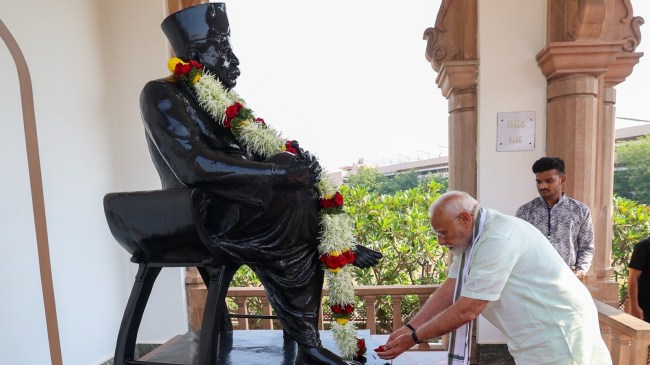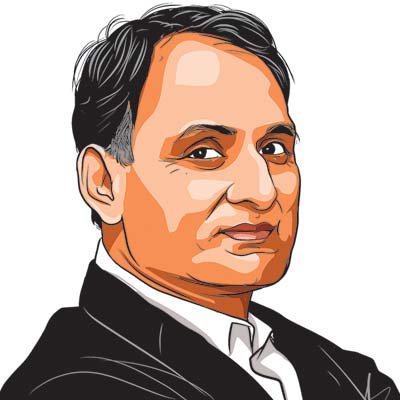Opinion K B Hedgewar and the roots of the RSS: A progressive movement that is misunderstood – internally and externally
The RSS remained at a distance from the political activities of the Hindu Mahasabha, which wanted trained swayamsevaks to work for its agenda. Hedgewar’s position upset the Mahasabha and the leaders of other Hindu organisations
 Hedgewar avoided binaries both in principle and practice (PTI Photo)
Hedgewar avoided binaries both in principle and practice (PTI Photo) The Rashtriya Swayamsevak Sangh has been an important component of India since the 1930s. In March 1934, there was a two-day discussion on the RSS’s ideology, leadership and activities in the Legislative Council of the Central Provinces & Berar. Again, in February 1947, the Central Assembly debated these issues. The change in the power dynamic in national politics since the 1990s is largely attributed to its organisational and ideological impact.
Isn’t it ironic, then, that the founder of RSS, K B Hedgewar’s vision and action got little space in these conversations? There is, however, an exception. In the pre-Independent period, after his death on June 21, 1940, newspapers and journals across the country, from Modern Review, edited by Ramananda Chatterjee and published from Calcutta, to the Marathi daily Kesari, founded by Gangadhar Tilak in Pune, debated his idea of India for months.
 At the age of 36, he visualised a movement whose sole objective would be to regain India’s civilisational characteristics. He did not initiate a new stream of Hindutva. Rather, for him, the consolidation of Hindus was a means to achieve all-around development of the nation. During his time, the efforts to unite Hindus were based on philanthropy and preaching the ideas of social reformers on the one hand and the politics of the Hindu Mahasabha on the other. Both approaches proved, by and large, to be inadequate to address the basic causes of injustice and discrimination against marginalised castes.
At the age of 36, he visualised a movement whose sole objective would be to regain India’s civilisational characteristics. He did not initiate a new stream of Hindutva. Rather, for him, the consolidation of Hindus was a means to achieve all-around development of the nation. During his time, the efforts to unite Hindus were based on philanthropy and preaching the ideas of social reformers on the one hand and the politics of the Hindu Mahasabha on the other. Both approaches proved, by and large, to be inadequate to address the basic causes of injustice and discrimination against marginalised castes.
In A Dying Race (1908), U N Mukherji vehemently criticised upper-caste and -class Hindus for being insensitive to their own people. This was among the first works that put forth the idea that the reasons for the decline of Hinduism, besides the threats from Semitic religions, were its internal weaknesses. Three years later, B R Ambedkar questioned the claims of the Congress, Hindu saints, socialists and communists in What Congress and Gandhi have done to the Untouchables.
Hedgewar believed that symbolism and social Fabianism cannot lead to a sense of equality and social cohesion – what the RSS calls samrasta. This was a visible departure from the elitist approach based on high-minded speeches and symbolic programmes like co-dining and co-option of social groups to address socio-cultural problems. Hedgewar realised feudalism was the mother of status-quoism, and the social and political elites had a stake in it. Even the revolutionary claims of socialists and communists against it were confined to speeches and resolutions. Hedgewar turned the table.
He did not solicit support or patronage from any major political personality or massive funds during his 15-year leadership of the RSS. He relied on school and college teachers, clerks, graduates and common men, including orphans, to build up a movement. Others considered them just part of a crowd. Hedgewar groomed them as leaders of social and cultural movements. RSS workers actively spread the idea of undoing caste hierarchies. The “untouchability” question has been dealt with systematically by the Sangh. For this, it silently bore the brunt of conservatives.
A conglomeration of saints of all streams and sects, along with the Shankaracharyas in Udupi in 1969, dealt the death blow to the abiding, false perception among a powerful section of religious leaders and upper castes that untouchability had religious sanction. RSS Chief M S Golwalkar was the architect of this great leap forward. The battle against social conservatism — across countries and epochs — has been the most difficult of tasks. Despite Washington, Lincoln, Jefferson and Obama, the acrimony between Black and White people persists in the US. Apartheid’s legacy of inequality continues in some ways today, despite decades-long campaigns against it.
The dynamism of an organisation and ideology is rooted in its openness, ability to accept its limitations and introduce corrective measures. The RSS possesses these features. Early on, it carried out surveys in hundreds of villages in Maharashtra to compare the Sangh’s intent to foster social change with its actual effect. In 1974, the third Sarsanghachalak Balasaheb Deoras said, “Untouchability should go lock, stock and barrel.” Mohan Bhagwat gave this principle a practical formulation as a task for the organisation – to ensure “common wells, common temples and common mortuaries.” In 1910, the Census Commissioner E A Gait issued a questionnaire to determine who was a Hindu. It included questions about those who were deprived of using common wells, ponds, mortuaries and temples. Known as the Gait Circular, it was eventually withdrawn before the 1911 census after protests by Hindu leaders, including Lajpat Rai.
Hedgewar was aware of the pitfalls of electoral politics. The RSS remained at a distance from the political activities of the Hindu Mahasabha, which wanted trained swayamsevaks to work for its agenda. Hedgewar’s position upset the Mahasabha and the leaders of other Hindu organisations. Critics of the RSS ignore these internal challenges when they view Hindutva as a singular entity. Nathuram Godse was one such disillusioned worker who, along with four Hindutva activists, wrote to Savarkar, blaming the RSS for wasting the energies of Hindu youth. The files of the Mahasabha in the Prime Minister’s Museum and Library, Teen Murti (Delhi) have umpteen such examples of clashes between the Sangh and Mahasabha. This is reflected today, too. Many feel the RSS is too liberal on the minority question.
Hedgewar avoided binaries both in principle and practice. This is a reason that RSS cadres do not hesitate while helping and serving non-Hindus — from food camps in 1950 and during the India-China war in 1962 to earthquake relief in Latur in 1993 and the plane crash in Ahmedabad in 2025. Stray statements and local incidents must not be seen as emanating from the RSS’s philosophy. Using them as such only obstructs healthy dialogue and harms national interest.
RSS had a modest beginning. It worked without an office or signboard for years. Office bearers were created after three years. Till then, it functioned like a commune. 100 years of the RSS is an occasion for both its critics and admirers to understand the message of Hedgewar: Selflessness and keeping the common person at the centre will keep an ideology and movement alive.
The writer is a former Rajya Sabha MP (BJP)






